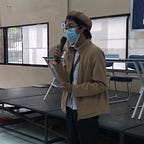From Apartments to Streets: Deconstructing Yasmina Reza’s Art
--
“Art is now utilized to signify intellectual and financial superiority — a deviation from its real purpose as a branch of the humanities which is to be of depth, to be oriented in reality and not profit, and to be a tool that captures even the ugliest human element.”
Art by Yasmina Reza is a play that follows three characters whose friendship was put to the test because of a 200,000 francs all-white painting. These characters, namely Serge, Marc, and Yvan, can be interpreted as representations of different art theories. Firstly, Serge, as manifested by his purchase of a modern Antrios painting, represents expressionism. In Scene 3, he hinted to Yvan that it takes a moment for one to understand the meaning of the painting because expressionist art focuses on conveying the abstract and intangible (e.g. emotions) with utmost specificity (Collingwood 1938; Stecker 2003). This is compared to representational art, as represented by Marc, which simply mimics our physical world and its elements — making it understandable even in immediate view (Stecker 2003). Marc constantly rejected the modernity of the Antrios due to his bias toward the mimetic and realist standards of classical art, as confirmed by Yvan in Scene 3. Lastly, Yvan, who found the colors of the painting “touching” in Scene 5, represents formalism. He claimed that the said colors evoked a magnetic resonance akin to aesthetic emotion, a reaction produced by significant form (Bell 1914).
The play ends with Marc drawing a disappearing skier in the Antrios which possibly alludes to three things: him leaving his pretentiousness behind for the sake of saving his friendship, Serge leaving Marc behind in pursuit of his independence from the latter’s intellectual mentorship, and Yvan’s struggle for agency. This final act is also the play’s way of defining art — that it can be both meaningful and meaningless; and it is the audience, like Marc, through their personal experiences that give meaning to an artwork.
However, to say that art can be meaningless puts it in a vacuum. It takes away the politics behind it vis-à-vis the fact that all artworks reflect their creators’ material conditions, whether they intended to or not (Mao 1956). Despite this refutation, I still agree with how the play made a commentary on how art as an institution has become an ivory tower. Art is now utilized to signify intellectual and financial superiority — a deviation from its real purpose as a branch of the humanities which is to be of depth, to be oriented in reality and not profit, and to be a tool that captures even the ugliest human element. Beyond being an inaccessible institution, art is also used by the ruling class to develop a hegemonic culture (Cole 2020). Aside from the violence of the military-industrial complex, the state now uses cultural production to create more profit and promote ahistorical fascist values as exemplified by the recent film Maid in Malacañang.
The aforementioned criticisms now beg the question: what is art for me? As a national democratic propagandist, I define art for what it is not: something made for its own sake. In the materialist sense, art must serve the people by advancing a nationalist, scientific, and mass-oriented (NSMO) culture and must disturb the ruling class. Under the NSMO framework, our cultural production will finally cater to the needs of the country and its sovereignty; our artistic process will include the correct analysis of our country’s concrete conditions and the rejection of feudal and colonial culture; our artworks themselves will be made accessible to the masses and not monopolized by bureaucratic institutions like elite-owned museums and galleries (e.g. Ayala Museum of the Zóbel de Ayala dynasty).
The need to disturb the ruling class, on the other hand, suggests that there is more to art than satisfying standards on aesthetics or form. Fernando Amorsolo’s commissioned glorification of the Philippine countryside, far from the toiling conditions of peasants and workers under colonization, is proof of the dangers of focusing on beauty alone (Guillermo n.d.). Hence, the best way to shed light on the ills of our society is by exposing them in an equally ill manner and asserting the inevitable downfall of the ruling class that perpetuates them — like protest effigies made to be deconstructed by fire.
In assessing if something is art, we must ask ourselves a simple question: “Who does it serve? Who does it disturb?” Expressionism, representationism, and formalism will remain pretentious schools of thought if not used in the service of the people and the disturbance of the ruling class. As we look back at Serge’s all-white painting, I leave this declaration by Pablo Picasso: “Paintings are not done to decorate apartments; they are instruments of attack and defense against the enemy.”
Unlike Antrios, may we always choose the latter.
References
Bell, Clive. Art. London: Chatto and Windus, 1914.
Cole, Nicki Lisa. “What Is Cultural Hegemony?” ThoughtCo. January 5, 2020. https://www.thoughtco.com/cultural-hegemony-3026121
Collingwood, Robin George. The Principles of Art. Oxford: Oxford University Press, 1938.
Guillermo, Alice. “The History and Current Situation of Modern Art in the Philippines.” Japan Foundation. Accessed September 12, 2022. https://www.jpf.go.jp/j/publish/asia_exhibition_history/pdf/15_Symposium-1994_Potential_ENG_Handout_2.pdf
Mao, Zedong. Talks at the Yenan Forum on Art and Literature. Amsterdam: Amsterdam University Press, 1956.
Stecker, Robert. “Definition of Art.” In The Oxford Handbook of Aesthetics, edited by Jerrold Levinson, 136–154. Oxford: Oxford University Press, 2003.
Written by Allen John Dela Cruz on September 2022 for Critical Perspectives in the Arts.
